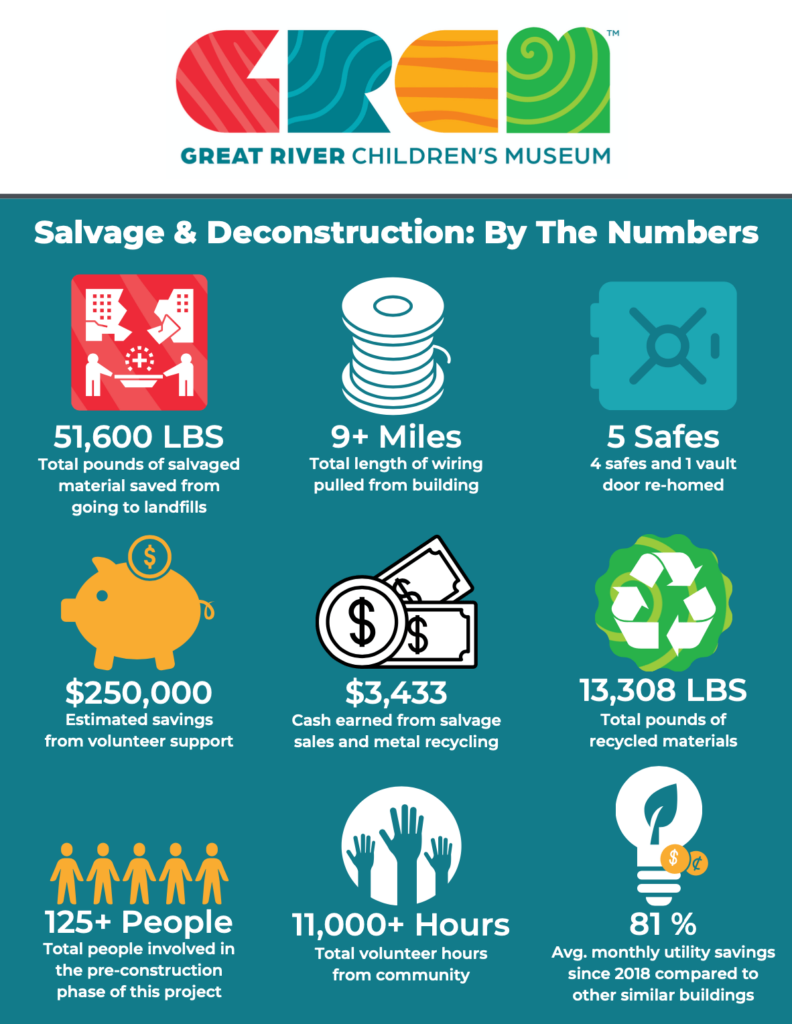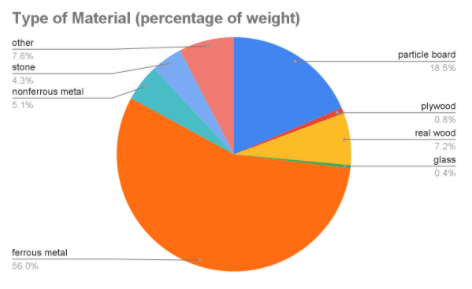The downtown St. Cloud building that is the future home of the Great River Children’s Museum has undergone dramatic changes over the past 4 months. Salvagers and volunteers have carefully removed thousands of pounds of materials for reuse and recycling in preparation for a demolition team to begin the transformation of the building in order to construct the museum.
The deconstruction process was coordinated by David Mohs, the lead facilities volunteer. He describes the process he created that led to 25 tons of materials and fixtures being removed from the building for reuse or recycling.
First, an online database of building fixtures including photographs was created. This inventory was then shared with GRCM representatives, who claimed items for GRCM’s preservation and for personal use. Technicians and volunteers who toured or had worked in the buildings were also invited to claim items. Nonprofit organizations and government agencies were invited to review the inventory through an announcement via the Saint Cloud Area Human Services Council. Select items were marketed on Freecycle and the Minnesota Materials Exchange. Eventually, people who participated in the salvage project were encouraged to invite others. Word of mouth was the most successful method of finding salvagers.
All materials were available for free, with a few exceptions. For example, salvagers could not take copper and other valuable metals unless they paid more than the recycling value. Salvagers provided their own labor and tools to reclaim the desired materials. Each was required to sign a liability waiver covering injury, damage, and regulatory responsibility. The serious salvagers typically fell into one or more of these categories: (a) persons employed in facilities management, (b) nonprofits/governments with a dedicated facilities staff, or (c) people with farming backgrounds.
Over 50 individuals and groups participated in this process. Some examples of salvaged materials and salvagers who participated included. A school that claimed 800 pounds of shelving and building materials for theatrical sets. A government entity claimed 1400 pounds of cabinets and counters used by their guests. A non-profit that serves persons with disabilities claimed over 1,700 pounds of materials to be used for various improvements. A farm family claimed 3,000 pounds of lumber and ceiling tiles to remodel a barn.

In addition to the materials that were salvaged for reuse, there were also materials that were dismantled and collected for recycling by 10-15 GRCM volunteers. These materials were taken to the local recycling business and brought in $4-5,000 to the organization.
There were a variety of materials that were salvaged or recycled including: wood products, glass, metal, stone and other. The graph below shows categories of materials by weight.

This deconstruction process had multiple benefits for GRCM, the community and our collective environment. The museum benefited by reducing the costs of demolition through saving time and effort on the part of the demolition crew who could do their work more efficiently and with less having to be taken away. In addition, recycling metals that provided some additional income. The benefits to the community were that individuals, non-profits, schools and churches were able to find fixtures and materials that they could use by reclaiming them with their labor. There were over 25 tons of materials removed from the building that did not end up in a landfill that benefits us all.
A big thanks to 50+ salvagers and volunteers who participated in the deconstruction process that has supported GRCM to move to focusing on the construction of a children’s museum. A special thanks to David Mohs who led this deconstruction project from building a database of materials to contacting salvagers and spending countless hours preparing the building, coordinating volunteers, and assisting salvagers.
